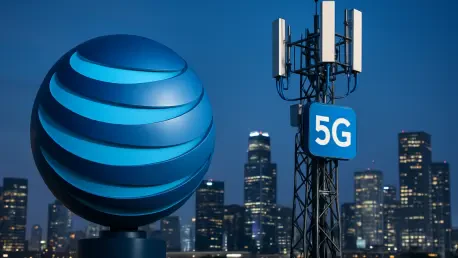In an era where seamless connectivity is no longer a luxury but a necessity, the telecommunications industry continues to push boundaries to meet escalating demands for speed and coverage. AT&T has emerged as a frontrunner in this race, recently achieving a remarkable feat by significantly enhancing its 5G network through a strategic acquisition of spectrum from EchoStar. This move has not only expanded coverage across vast swaths of the United States but also delivered unprecedented speed improvements for millions of users. By integrating this newly acquired spectrum at a record pace, AT&T has set a new benchmark in network deployment, addressing the growing appetite for robust mobile and fixed wireless access (FWA) services. This development marks a pivotal moment in the company’s journey to maintain a competitive edge, showcasing how strategic partnerships and swift execution can reshape the landscape of digital connectivity in a fiercely contested market.
Strategic Spectrum Acquisition and Rapid Rollout
AT&T’s acquisition of the 3.45 GHz spectrum from EchoStar represents a calculated step toward bolstering its 5G infrastructure to meet soaring consumer expectations. This deal, valued at a staggering $23 billion, enabled the company to secure a critical resource that had remained untapped by EchoStar, largely due to regulatory uncertainties and internal strategic shifts. What stands out is the speed of integration—within just weeks, AT&T deployed this spectrum to nearly 23,000 cell sites, extending coverage to almost two-thirds of the U.S. population by mid-November. This rapid rollout was made possible through a short-term spectrum management lease, a clever maneuver that allowed deployment to begin even before regulatory approval of the deal, which is anticipated to finalize in the coming year. Such agility underscores AT&T’s commitment to enhancing network capacity and positions it as a leader in leveraging available resources to address immediate market needs with precision and foresight.
Beyond the initial deployment, the acquisition also includes a 20 MHz portion of EchoStar’s 600 MHz spectrum, though its integration is expected to take a couple of years due to AT&T’s current lack of operations in this frequency band. The untouched state of the 3.45 GHz spectrum prior to the deal provided a unique advantage, as there were no existing technical entanglements to navigate. EchoStar’s hesitation, influenced by uncertainties around FCC decisions on CBRS 3.5 GHz power levels and an ongoing investigation into its spectrum usage, ultimately paved the way for this seamless transition. This scenario allowed AT&T to bypass many of the typical hurdles associated with spectrum integration, focusing instead on scaling up infrastructure to deliver enhanced services. The result is a strengthened network foundation that not only caters to current demands but also prepares AT&T for future growth in an increasingly data-driven world.
Impact on Customer Experience and Network Performance
The deployment of EchoStar’s spectrum has yielded tangible benefits for AT&T customers, significantly elevating the quality of both mobile and fixed wireless access services. Reports indicate that mobile users are now experiencing download speeds up to 80% faster, while Internet Air FWA customers have seen improvements of around 55%. These enhancements are a direct outcome of the expanded network capacity, which allows for smoother data transmission even during peak usage times. Chief Operating Officer Jeff McElfresh has highlighted how these upgrades translate into immediate, noticeable benefits for subscribers, reinforcing AT&T’s reputation for reliability. Furthermore, a recent RootMetrics report crowned AT&T as having the best overall network in the first half of the current year, a testament to the effectiveness of this strategic spectrum integration in delivering superior connectivity across diverse user bases.
This performance boost aligns with broader industry trends where speed and coverage are paramount in retaining customer loyalty and attracting new subscribers. The enhanced 5G capabilities are particularly crucial in the growing FWA market, where dependable high-speed internet is becoming a cornerstone for both residential and business applications. By capitalizing on the newly acquired spectrum, AT&T has managed to address congestion issues in high-traffic areas, ensuring that users experience consistent service quality regardless of location. This achievement not only solidifies AT&T’s standing among competitors but also sets a high standard for what consumers can expect from modern telecommunications providers. The focus on immediate impact through strategic deployment reflects a deep understanding of market dynamics, positioning the company to adapt swiftly to evolving technological and consumer landscapes.
Competitive Dynamics and Market Positioning
In parallel with technical advancements, AT&T has intensified its efforts to shape public perception through targeted advertising campaigns. A recent initiative featuring actor Luke Wilson directly challenges rival T-Mobile, asserting that AT&T’s network coverage vastly surpasses that of its competitor while accusing T-Mobile of misleading advertising practices. This bold move mirrors a similar campaign by T-Mobile, highlighting the cutthroat nature of competition in the telecommunications sector where every claim to superiority is fiercely contested. The ad war has not gone unnoticed, drawing attention from BBB National Programs Inc., which prompted AT&T to respond with a lawsuit against a cease-and-desist letter. Such disputes underscore the critical role of brand image and network reliability as battlegrounds where companies vie for consumer trust and market dominance.
Beyond advertising, AT&T’s broader strategy of aggressive 5G infrastructure expansion through acquisitions like EchoStar’s spectrum signals a proactive approach to staying ahead in a crowded field. The ability to rapidly deploy resources and translate them into customer benefits provides a significant edge, particularly as demand for high-speed connectivity continues to surge. This multifaceted approach—combining technical innovation with assertive marketing—illustrates how AT&T navigates the complexities of the industry. By addressing both the functional and perceptual aspects of competition, the company ensures that its advancements are not only felt by users but also recognized in the public domain. This dual focus is essential in an environment where technological prowess alone is insufficient without a strong narrative to support market positioning.
Reflecting on a Milestone Achievement
Looking back, AT&T’s swift integration of EchoStar’s 3.45 GHz spectrum into nearly 23,000 cell sites stood as a defining moment in its quest to enhance 5G and FWA services. The remarkable speed of deployment, coupled with substantial improvements in download speeds for customers, highlighted the effectiveness of strategic foresight and operational efficiency. The ease of incorporating previously unused spectrum, alongside a temporary lease arrangement, demonstrated a calculated approach to expanding coverage well ahead of formal deal closure. Meanwhile, concurrent marketing efforts and legal skirmishes over advertising claims revealed the intense competitive undercurrents shaping the industry. Moving forward, stakeholders can anticipate further innovations as AT&T continues to build on this foundation, potentially exploring additional spectrum integrations and refining customer offerings to sustain its leadership. This milestone serves as a blueprint for how strategic acquisitions, paired with rapid execution, can redefine connectivity standards for the future.









